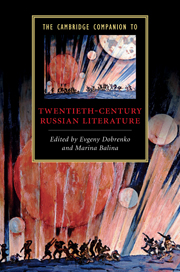Book contents
- Frontmatter
- 1 Poetry of the Silver Age
- 2 Prose between Symbolism and Realism
- 3 Poetry of the Revolution
- 4 Prose of the Revolution
- 5 Utopia and the Novel after the Revolution
- 6 Socialist Realism
- 7 Poetry after 1930
- 8 Russian Epic Novels of the Soviet Period
- 9 Prose after Stalin
- 10 Post-Soviet Literature between Realism and Postmodernism
- 11 Exile and Russian Literature
- 12 Drama and Theatre
- 13 Literature and Film
- 14 Literary Policies and Institutions
- 15 Russian Critical Theory
- Index
7 - Poetry after 1930
Published online by Cambridge University Press: 28 May 2011
- Frontmatter
- 1 Poetry of the Silver Age
- 2 Prose between Symbolism and Realism
- 3 Poetry of the Revolution
- 4 Prose of the Revolution
- 5 Utopia and the Novel after the Revolution
- 6 Socialist Realism
- 7 Poetry after 1930
- 8 Russian Epic Novels of the Soviet Period
- 9 Prose after Stalin
- 10 Post-Soviet Literature between Realism and Postmodernism
- 11 Exile and Russian Literature
- 12 Drama and Theatre
- 13 Literature and Film
- 14 Literary Policies and Institutions
- 15 Russian Critical Theory
- Index
Summary
The lasting prestige of twentieth-century Russian poetry flows from those poets who endured the Stalin years with honour and integrity. Poets are thought to have performed hidden acts of heroism when they took the simple risk of composing verse. Some famous images of the 1930s come from these poems, including the woman who whispers with blue lips in ‘Requiem’ by Anna Akhmatova (1889–1966). She described the internal exile of Osip Mandelshtam (1891–1938) as a time when fear and the muse stood guard. His poems, and the memoirs of his widow, Nadezhda Mandelshtam, made him the emblematic poet of Russia’s modern time of troubles.
Life for Russia’s poets was more complex than these dramatic images suggest. The dangerous 1930s were also an era for cultural negotiation and the sheer work of imagining a readership. Both efforts continued as the Soviet Union evolved, and as it collapsed in the 1980s. The flourishing of post-Soviet poetry merits separate treatment, but most contemporary poets came of age in the late Soviet period, so it makes sense to see these decades as a strangely unified epoch, with several persistent features. Indeed the late Mikhail Gasparov argued that rhythmic innovations and the presence of semantic aureoles for metrical patterns are surprisingly constant across the many decades.
- Type
- Chapter
- Information
- The Cambridge Companion to Twentieth-Century Russian Literature , pp. 115 - 134Publisher: Cambridge University PressPrint publication year: 2011
- 1
- Cited by

